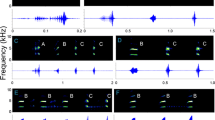Summary
-
1.
Three types of calls are known so far of male European treefrogs: mating call, territorial call and distress call. The pattern of the mating call is very specific. The basic unit is a pulse-group which almost always consists of nine pulses. A number of pulse-groups make a series; the series are separated by pauses varying in length. The great majority of the recorded series consisted of 15–30 pulsegroups, but when the spawning activity reached its peak I heard very long series which consisted of several hundred of pulse-groups. The length of the series is not influenced by temperature. — When two calling frogs were sitting less than 10 cm apart from each other they produced territorial calls which induced them to move farther apart. The territorial call consists of very short pulses which are of irregular sequence and amplitude. — The distress call is a shrill scream. While fleeing in distress a frog may emit this type of call.
-
2.
In the area of Tübingen the treefrogs were calling from May 14th to July 5th, 1967. The daily calling periods began between 8 and 9.15 p. m. and had a variable duration. During the day the treefrogs stayed in the trees and bushes and at night moved to the pond for calling. When calling, the frogs were sitting on the ground next to the water line and usually did not change their positions for hours. Very often two treefrogs demonstrated alternating calling: both animals called at the same time but with a phase shift. The pulse-groups of one frog appeared during the intervals of the partner.
-
3.
The calling activity is influenced by the air temperature. The lower limit of the calling activity is 8° C, the upper lies above 20° C. The length of the daily calling periods depends upon the air temperature at the beginning of the periods and the following temperature decline. When the air temperature does not drop below 8° C during the night, the calling activity decreases around 12 p. m. and the frogs begin leaving the pond. Finally, the calling ends at about 1 a. m.
-
4.
The air temperature also exerts an influence on the mating call. When the air temperature rises, the number of pulse-groups produced per unit of time exhibits a linear positive regression, while the duration of the pulse-groups as well as their intervals demonstrate a linear negative regression.
Zusammenfassung
-
1.
Bei männlichen Laubfröschen ließen sich bisher drei Ruftypen nachweisen: Paarungs-, Revier- und Schreckruf. Das Muster des Paarungsrufes ist sehr differenziert. Die Grundeinheit ist eine Impulsgruppe, die fast durchweg aus neun Impulsen besteht. Eine Anzahl von Impulsgruppen ergibt eine Serie; die Serien sind durch unterschiedlich lange Pausen voneinander getrennt. Die Mehrzahl der registrierten Serien bestand aus 15–30 Impulsgruppen. Während der Hauptlaichzeit hörte ich im Verlauf von mehreren Tagen auch außerordentlich lange Serien, die sich aus mehreren Hundert Gruppen aufbauten. Die Länge der Serien ist nicht temperaturabhängig. — Rufende Laubfrösche, die weniger als 10 cm voneinander entfernt saßen, gaben den Revierruf ab und veranlaßten sich dadurch, den Abstand zwischen sich zu vergrößern. Der Revierruf besteht aus sehr kurzen Impulsen wechselnder Folge und Amplitude. — Der Schreckruf ist ein gellender Schrei, der bei plötzlicher Flucht ausgestoßen wird.
-
2.
An einem in der Nähe Tübingens gelegenen Teich riefen 1967 Laubfrösche vom 14. Mai bis 5. Juli. Die Rufphasen begannen abends zwischen 20–21,15 Uhr und dauerten unterschiedlich lange, maximal bis 1 Uhr. Tagsüber hielten sich die Laubfrösche in Bäumen und Sträuchern auf und wanderten abends zum Teich. Beim Rufen saßen sie an Land in nächster Nähe des Ufers und behielten ihre Plätze meist über Stunden bei. Häufig war ein Wechselrufen zu beobachten: Zwei Tiere riefen zur gleichen Zeit aber phasenverschoben, so daß die Impulsgruppen des einen Tieres in die Intervalle der Rufe des Partners fielen.
-
3.
Die Rufaktivität wird von der Lufttemperatur beeinflußt. Die untere Grenze der Rufaktivität liegt bei 8° C, die obere über 20° C. Die Länge der Rufphasen hängt von der Anfangstemperatur und der nachfolgenden Abkühlung ab. Sinkt die Lufttemperatur nachts nicht mehr unter 8° C, setzt trotzdem gegen 24 Uhr der Rückgang der Rufaktivität und die Abwanderung der Laubfrösche ein.
-
4.
Unter dem Einfluß der Lufttemperatur verändert sich auch der Paarungsruf selbst. Mit steigender Lufttemperatur zeigt die Zahl der Impulsgruppen, die pro Zeiteinheit abgegeben wird, eine lineare, positive Regression, die Dauer der Impulsgruppen und die Intervalle zwischen ihnen eine lineare, negative Regression.
Similar content being viewed by others
Literatur
Blair, W. F.: Mating call in the speciation of anuran amphibians. Amer. Naturalist 92, 27–51 (1958).
Bogert, Ch. M.: The influence of sound on the behavior of amphibians and reptiles. In: Animal sounds and communication (ed. W. E. Lanyon and W. N. Tavolga). Amer. Inst. Biol. Sci., Washington, 1960, p. 131–317.
Heinzmann, U.: Variabilität des Paarungsrufes der Geburtshelferkröte, Alytes o. obstetricans. Experientia (Basel), im Druck.
Littlejohn, M. J.: Call differentiation in a complex of seven species of Crinia (Anura, Leptodactylidae). Evolution (Lancaster, Pa.) 13, 452–468 (1959).
Lörcher, K.: Einfluß der Wassertemperatur auf die Paarungsrufe der Unken. Naturwissenschaften 53, 559–560 (1966).
Mc Alister, W. H.: The vocal structures and method of call production in the genus Scaphiopus Holbrook. Texas J. Sci. 11, 60–77 (1959).
Schneider, H.: Die Paarungsrufe einheimischer Froschlurche. Z. Morph. Ökol. Tiere 57, 119–136 (1966).
-Bio-Akustik der Froschlurche. Stuttgarter Beitr. Naturkde. Nr. 152, 1–16 (1966).
Author information
Authors and Affiliations
Additional information
Mit Unterstützung der Deutschen Forschungsgemeinschaft.
Rights and permissions
About this article
Cite this article
Schneider, H. Rufe und Rufverhalten des Laubfrosches, Hyla arborea arborea (L.). Z. Vergl. Physiol. 57, 174–189 (1967). https://doi.org/10.1007/BF00303072
Received:
Issue Date:
DOI: https://doi.org/10.1007/BF00303072




